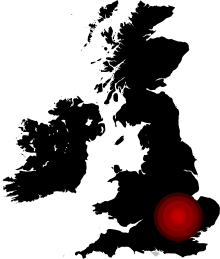Finding out a bit about Frogmore
Frogmore is a village just two miles south of St. Albans, in the parish of St. Stephen, Hertfordshire. It has a varied history, with a number of historical buildings still in situ, including the popular Holy Trinity Church of Frogmore.
The church was built in 1859, after the original church in the village – the church of St. Stephen, fell into a state of disrepair. Holy Trinity was designed by Sir George Gilbert Scott (1811 – 1878), who was an English Gothic revival architect, specialising in the design, building and renovation of churches and cathedrals. He designed or altered over 800 buildings during his working life, including many of today’s iconic building, such as the Midland Grand Hotel at St. Pancras Station, the Albert Memorial, King’s College Chapel, and the Foreign and Commonwealth Office. Outside of London, he was also responsible for the main building of the University of Glasgow, and St. Mary’s Cathedral.
Many years before Scott's time, there are indications that the Frogmore area was already an important centre in the years preceding the Roman Conquest (AD 43). Watling Street, the main road connecting Verulamium with the newly established Roman base in London, was laid out by the Roman army and still follows the same course. Why not take a drive along the road and experience a bit of the Roman Empire!
After the Norman Conquest, the area was known as ‘Parke Street’, and formed part of the land grant given to St. Albans monastery in 793 AD. The street’s mill - ‘Le Parkmulle’ (Park Street Mill) is first referred to in the twelfth century. The mill, which was converted into offices in the 1980s, was once used for grinding flour, and also supplied the Abbey with eels reared and trapped in the mill ponds. It ceased grinding flour in 1920, and was then used as a glue factory, and also a scrap metal store. The mill still forms a very prominent, tall feature in the centre of Park Street, and provides a pleasant backdrop to the war memorial garden to the north.
By the fourteenth century, Park Street was one of the largest and richest manors in the area, supplying large quantities of corn to the Abbey. There are still many buildings in Park Street and Frogmore of architectural or historic interest. The oldest buildings surviving appear to be numbers 61-63, which was originally a single early-15th century late medieval hall house, and number 68 - a sixteenth century timber framed building with the remains of a jettied front.
The late-nineteenth century saw the establishment of watercress beds in Park Street, alongside the River Ver. In 1885, part of the area used as a village green was leased out by the Council for watercress beds, at a time when Hertfordshire was the national centre for the industry.
As you can see, for a small village within the St. Albans area, Frogmore certainly has its place in history. Why not take a drive through the village, and experience the history for yourself?
Posted on May 27th 2015

